Tinea capitis caused by Trichophyton tonsurans presenting as an obscure patchy hair loss due to daily antifungal shampoo use
April 2015
in “Dermatology practical & conceptual”
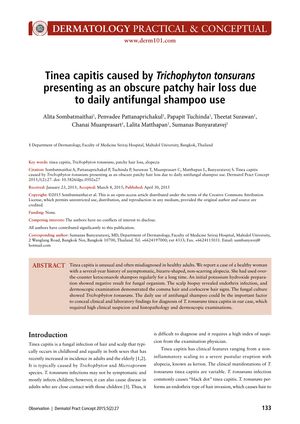
TLDR Daily use of antifungal shampoo can hide symptoms and make it hard to diagnose fungal scalp infections.
The document reports a case of a 38-year-old female primary school teacher with a history of asymptomatic, bizarre-shaped, non-scarring alopecia for several years, who had been using over-the-counter ketoconazole shampoo regularly. Initial tests, including a potassium hydroxide (KOH) preparation, were negative for fungal organisms. However, a scalp biopsy revealed an endothrix infection, and dermoscopic examination showed signs consistent with tinea capitis, such as comma hair and corkscrew hair. The fungal culture confirmed the presence of Trichophyton tonsurans. The study suggests that the daily use of antifungal shampoo may have concealed the clinical and laboratory findings, making diagnosis difficult. The patient was eventually treated with griseofulvin and ketoconazole shampoo, leading to a complete clinical cure. The case highlights the importance of high clinical suspicion and the use of histopathology and dermoscopic examinations for the diagnosis of T. tonsurans tinea capitis, especially when initial tests are negative and the presentation is atypical.
View this study on dpcj.org →
Cited in this study
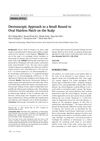
research Dermoscopic Approach to a Small Round to Oval Hairless Patch on the Scalp
Dermoscopic examination helps diagnose different types of hair loss conditions by showing specific patterns.
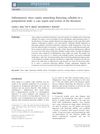
research Inflammatory tinea capitis mimicking dissecting cellulitis in a postpubertal male: a case report and review of the literature
A young man was initially misdiagnosed with a scalp condition but was found to have a fungal infection, which improved with antifungal treatment.
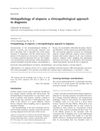
research Histopathology of alopecia: a clinicopathological approach to diagnosis
The conclusion is that accurate diagnosis of different types of hair loss requires good teamwork between skin doctors and lab experts.
Related

research Tinea capitis caused by Trichophyton tonsurans presenting as an obscure patchy hair loss due to daily antifungal shampoo use
Daily use of antifungal shampoo can hide symptoms and make it hard to diagnose fungal scalp infections.
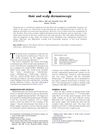
research Hair and scalp dermatoscopy
Dermatoscopy is useful for identifying different hair and scalp conditions and can reduce the need for biopsies.